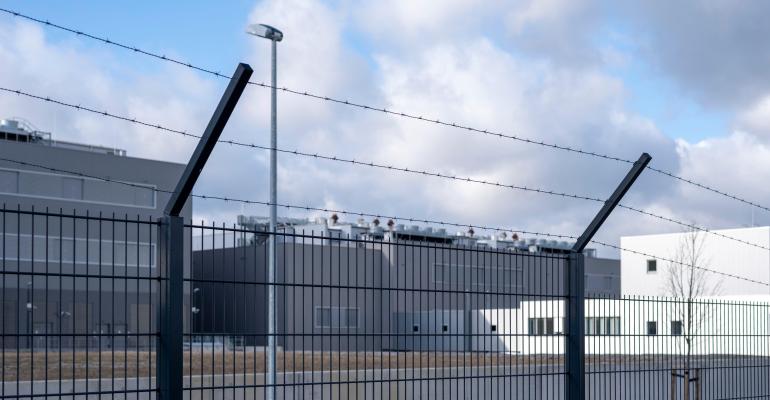Data center operators face an increasingly hostile landscape. As investment into cloud, artificial intelligence (AI), and big data analysis continues to grow, the facilities hosting these critical workloads become bigger targets for security threats. The value of information housed in data centers opens the pathway to potential damage caused by an unplanned outage.
Physical data center breaches remain rare. Between 2006 and 2016, there were only five reported physical incidents of sabotage or theft of equipment from a data center. By contrast, there were more than 70 significant data breaches impacting data center as a result of cyber-attacks in the first half of 2023 alone.
Nevertheless, researchers from the Uptime Institute note in a recent report that, when it comes to physical security and data centers, “a lack of incidents across the industry is a sign of success,” not of a lack of credible threats.
The report adds that the “likelihood of sabotage has grown, the surface area for attacks has expanded, and the methods used by intruders are increasingly sophisticated.”
Moreover, there is a tendency for data center physical security to focus on the first few lines of defense: perimeter security and controlling admission to the site.
While these measures are essential, they do not preclude the need for attention and investment into securing the data center white space and the hardware it contains.
However, while data centers’ physical security precautions are consistently effective in keeping outsiders at bay, the greatest and most underappreciated risk to a data center’s physical security is intentional human sabotage by an actor with insider access.
The Outer Perimeter and the Insider Threat
Protecting your data center assets from physical interference in the white space and managing vulnerability to insider – as well as outsider – interference is vital.
Once access to the hardware in a data center’s white space is obtained, the capacity to do immense damage is great, both to the company whose digital assets have been tampered with, as well as the data center owner's reputation.
This is an industry where companies live or die by their ability to maintain uptime. This is an economic landscape where businesses succeed or fail by their ability to consistently provide digital services. Pull the right cable to cause an outage at the right moment and you can pull the plug on a company's share price.
Looking at the multiple layers of physical security that surround a data center, it’s easy to assume the system is threat-proof, at least, relative to the value of the building’s contents. Razor wire, locked gates, armed security personnel, and facial recognition are all common precautions, even at your average retail colocation facility.
Still, people underestimate the macroeconomic conditions that could incentivize an attack against a data center – the economic value of a competitor in the marketplace suffering, and the potential to damage the assets of a rival nation. The threat of corporate espionage is an accepted risk in highly competitive industries, especially those undergoing disruption.
For example, the current investment in artificial intelligence is massive and widespread. Generative AI, specifically, has the potential to be the most economically and socially impactful technology of the decade.
There has been a great deal of data center capacity leased in the last three months to host generative AI workloads, and many of the key players in the space are gearing up for the next phase of the AI arms race.
Any time a phenomenon starts being referred to as an “arms race”, there are going to be vested interests willing to consider, explore, and potentially engage in sabotage to get ahead. The economic incentives of physically interfering with a data center should not be underestimated.
However, physical breaches remain a highly preventable threat if data center operators are willing to take the appropriate precautions. With multiple layers of physical security, identity confirmation, and authentication, it is virtually impossible for an outsider to gain unauthorized access to physical data center assets.
The same cannot be said for an insider, however – someone with access to the outer perimeter, the facility building, and even the data hall itself.
This is why the final layer, the caging and containment, is the most important. It is the last line of defense that prevents the equipment from being destroyed or tampered with, and it’s the layer that grants the customer the greatest control. The only way someone is getting in a server cage is if the customer who owns what's in that cage wants you in there.
Securing the White Space
As imperative as perimeter security is to safeguarding data centers’ physical assets, security measures within the white space itself may be even more essential.
There may be multiple layers of physical security outside the white space, but inside the data hall, only two things are standing between an intruder and the servers: the containment aisle door and the cage.
This is especially important in a retail colocation environment, where multiple clients can share a single data hall. Without effective caging solutions, access to the data hall at large can easily translate into the opportunity to sabotage any hardware hosted there.
Successfully deploying caging solutions to secure your white space is a pivotal part of the installation process.
Data center caging impacts a variety of infrastructure within the white space. If the cage extends into the flooring, it can interfere with power distribution unit cables. If it goes into the ceiling, it can impact fiber optic cabling and fire suppression systems.
Having a caging partner who understands the makeup of the entire white space environment means you can take a more agile, intelligent approach to caging design. Housing your data center assets inside a caging environment that you trust is just as important as colocating those assets with a provider with strong perimeter security.
Sam Prudhomme is President of Accelevation's Data Center business unit.





